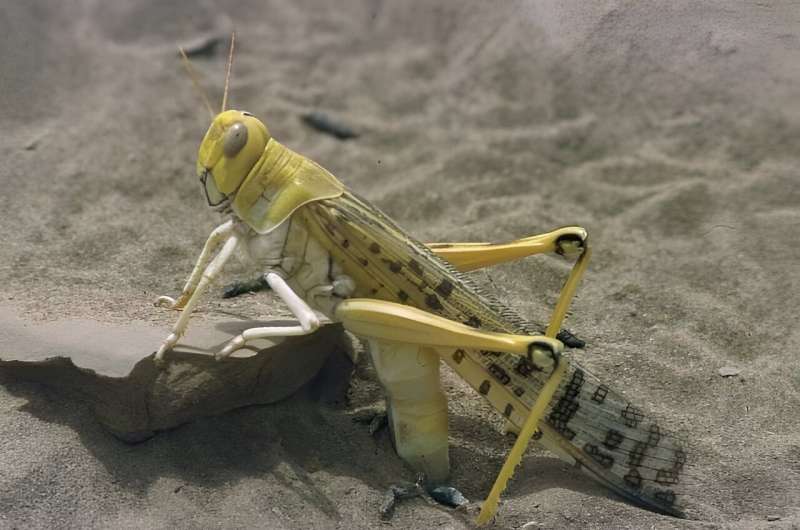This article has been reviewed according to Science X's editorial process and policies. Editors have highlighted the following attributes while ensuring the content's credibility:
fact-checked
trusted source
proofread
Desert locusts' jaws sharpen themselves, materials scientist discovers

Sharks lose teeth all their lives, replacing them in a kind of endless rotating Rolodex, while humans, of course, get only our two sets. Beavers' teeth, notoriously, grow all their lives and have to be worn down to prevent injury.
New research appearing in Interface Focus has now placed another animal into the self-sharpening set, Schistocerca gregaria, the desert locust.
Ulrike G. K. Wegst, research associate professor of physics at Northeastern University, has discovered that locust exoskeletons build up concentrations of zinc in their mandibles, which hardens their "shovel-shaped mouthparts"—according to the research—in relation to the surrounding cuticle.
A locust's exoskeleton is composed of chitin, a fibrous material not unlike the cellulose found in plants and common to both insects and marine life like crustaceans.
An animal's chitin varies depending on use. In some parts of the body it needs flexibility—e.g., around jaws that need to open and close—and in others it needs significant hardness.
Conducted in collaboration with biologist Oliver Betz, of the University of Tübingen, and Peter Cloetens, from the European Synchrotron, the research examined how zinc-hardened parts of the locusts' mandibles sharpen themselves as they're used.
The jaws of locusts aren't unlike human jaws, in that one set slightly overlaps the other set, although locusts' open and close horizontally.
As the two halves sheer past one another, the hardened edges sharpen each other.
Wegst, who specializes in materials science, identified a pronounced "zinc edge" lining along the mandibles through the use of a synchrotron—a kind of particle accelerator—that employed "monochromatic energy X-rays."
The benefit of synchrotron light resides in its intensity: "We can reduce the spectrum to a very narrow energy. In fact, we can make it monochromatic," Wegst says, "so I can still have enough energy to image, but I can also exactly position this energy."
Materials absorb X-rays differentially, and thanks to the narrowness of the synchrotron's beam the researchers could employ a process of subtractive imaging to "measure the amount of zinc on the one hand," Wegs says, and "more easily see how it is distributed in three dimensions."
In building a three-dimensional model of the locusts' jaws, Wegst could then identify how the harder leading edges of the locusts' mandibles cut away the softer chitin around them when used, thus maintaining a sharper edge.
"What I'm trying to obtain here in my cutting edge is a high hardness" that can stand up to highly abrasive, woody material, Wegst says. To "make sure that the cutting edges remain sharp as long as possible," she continues, can be "achieved by having one of these edges rubbing against the other. So every time it's cutting something, it's also sharpening itself."
But wear and tear is inevitable, despite this "very clever mechanism," as Wegst calls it. Eventually the edge will wear down—but, Wegst notes, the locust regularly sheds its exoskeleton, regrowing its chitinous outer shell and the hard, zinc-enriched mouthparts.
Imagine using a blunt knife instead of a sharp one, Wegst posits. "It costs more energy to cut, so for an animal that needs to eat and preserve energy, an efficient cutting mechanism is actually a strategy to survive. If I have blunt cutting tools—and I'm getting my new knife in six weeks—I may be starving in between."
"The animal that has the self-sharpening mechanism is at an advantage," she continues, "but it's also costly" for the locust to consume as much zinc as it needs and distribute it through the proper regions of the exoskeleton. "It's a balance that the organism seems to be striking," maintaining an efficient distribution "only in the areas where [the zinc] is most needed."
How the zinc reaches the mandibles, and how the locusts consume enough of it, remain open questions for further research.
While they may be out there, Wegst says that "we have not seen another species yet … where we have a similar arrangement of cutting edges with respect to one another."
But Wegst also foresees biomimetic design ideas rising out of this research. But that doesn't mean designing one-to-one copies. Rather, "biomimetics," she says, implies "understanding the principles of function."
The simple principle of placing "resources in specific areas to make something damage tolerant, resilient, and just long lived," Wegst says, "as long as my structure needs to survive," provides a lot to learn from.
More information: Ulrike G. K. Wegst et al, Desert locusts (Schistocerca gregaria ) feed with self-sharpening, scissor-like mandibles, Interface Focus (2024). DOI: 10.1098/rsfs.2023.0069
Provided by Northeastern University
This story is republished courtesy of Northeastern Global News news.northeastern.edu.


















